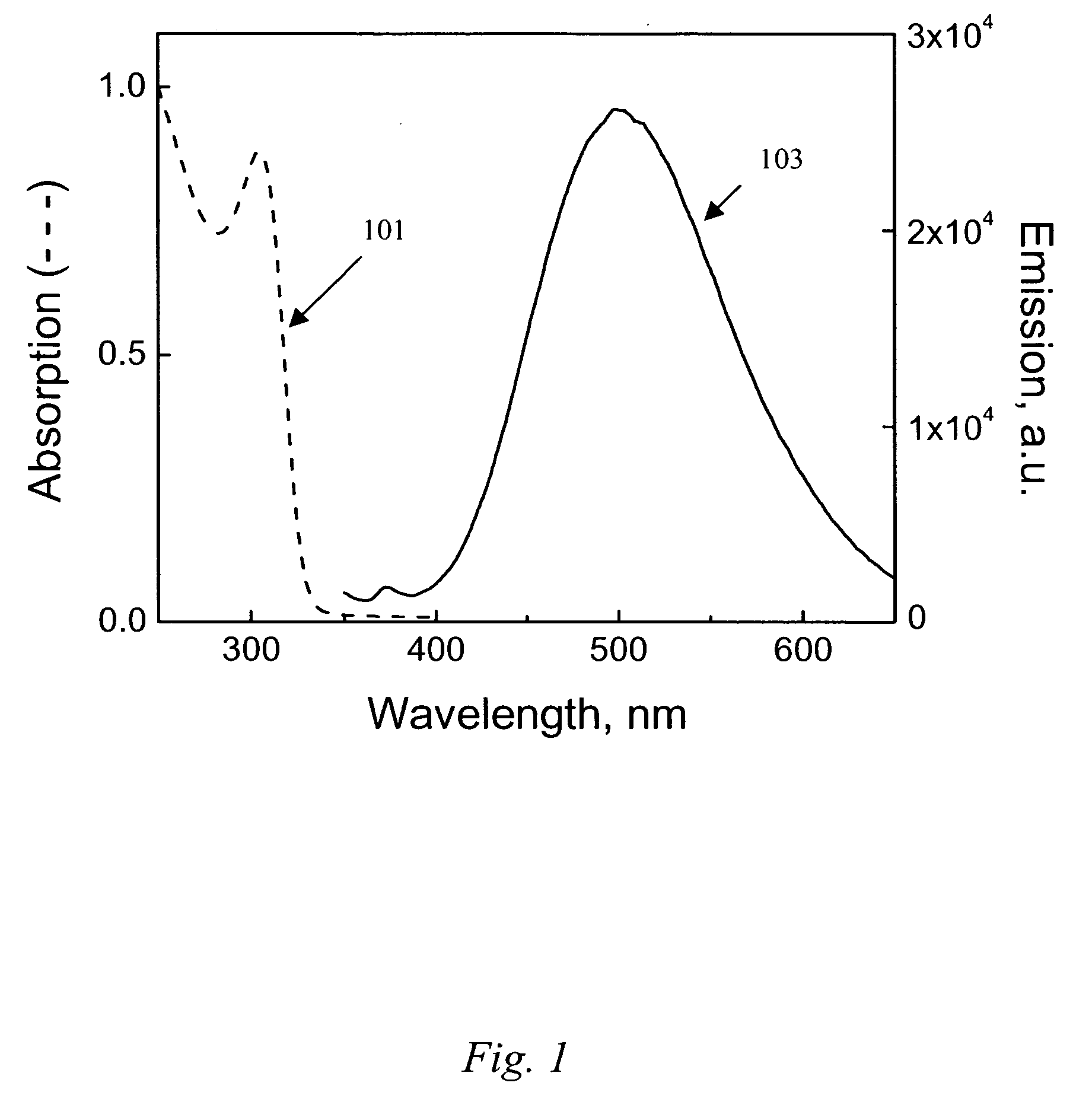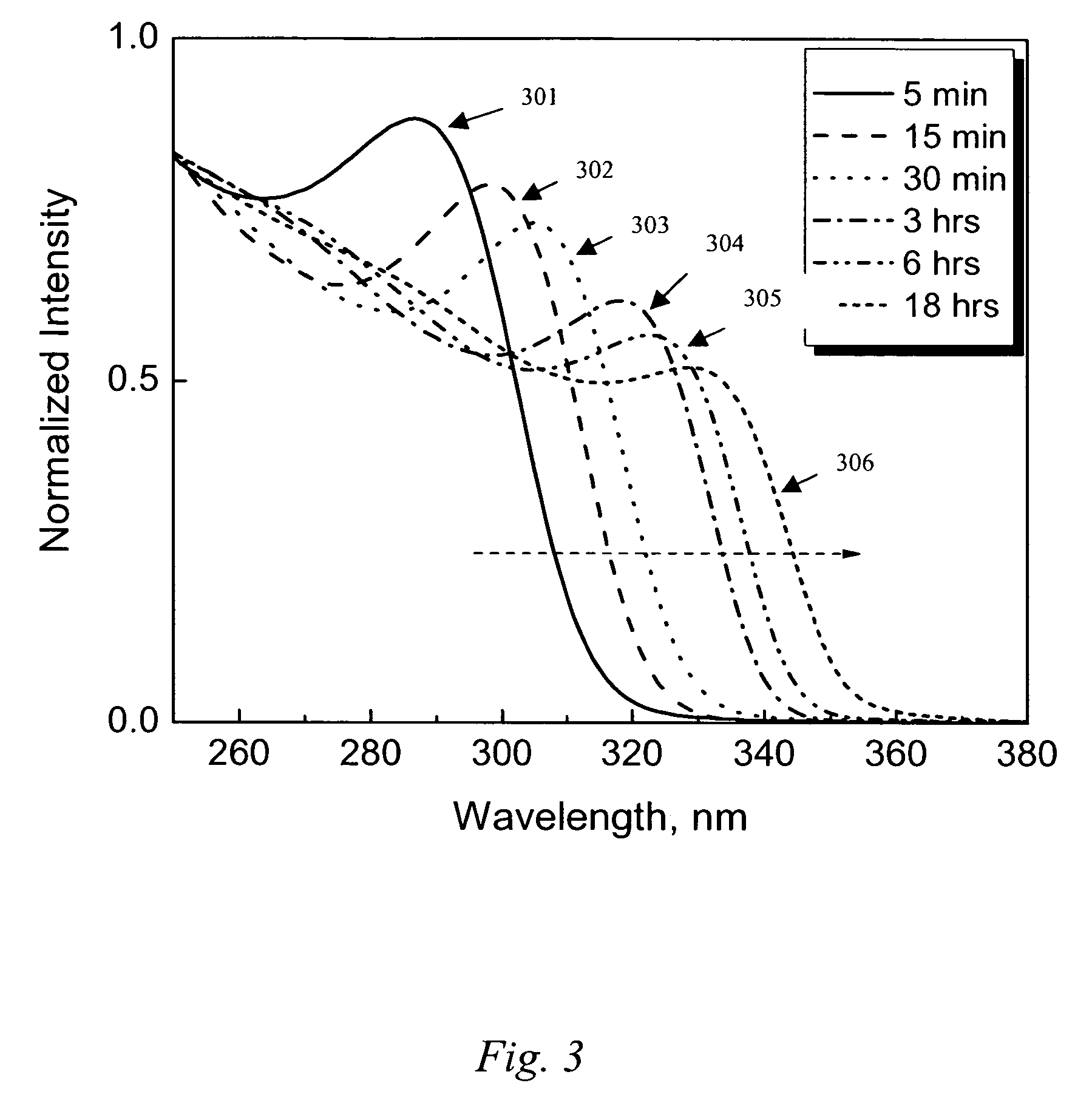Process for preparing nano-sized metal oxide particles
- Summary
- Abstract
- Description
- Claims
- Application Information
AI Technical Summary
Benefits of technology
Problems solved by technology
Method used
Image
Examples
example 1
[0043] This Example serves to illustrate a route, according to the present invention, of preparing ZnO colloids that is simpler and more general than those previously described in the literature.
[0044] Chemicals and solvents described in this and subsequent Examples were of reagent grade and used without further purification. Deionized water was used for pH measurements. pH measurements were made with a Beckman φ340 pH meter using a combined glass electrode with an operating range up to about pH 14, manufactured by Corning. UV-vis absorption spectra were recorded using either a HP 8451 diode-array spectrophotometer or a Shimadzu UV-1601 spectrophotometer. Spectra from the colloids were obtained with I cm quartz cells. Methanol was used as the reference solvent. Fluorescence spectra were recorded using a SLM Aminoco MC200 spectrofluorometer.
[0045] ZnO particle size was determined using a JEOL JEM-2010 TEM (transmission electron microscope) operating at 200 kV. Samples were prepared...
example 2
[0049] This Example serves to illustrate how the reactions described in EXAMPLE 1 are effected by different concentrations of KOH and different reaction stoichiometries of zinc acetate dehydrate and KOH. Toward this end, the pH values of the resulting solution and reaction mixtures were measured, and the absorption spectra of the solution and reaction mixtures were monitored, to verify whether or not ZnO colloids were formed for a particular set of reaction parameters. The experimental data is shown in Table I, wherein “initial” refers to the KOH / methanol solution before having added the zinc acetate dihydrate, “5 min” refers to the reaction mixture at 60° C.-5 minutes after having added the zinc acetate dihydrate, and “2 h” refers to the reaction mixture at 60° C.-2 hours after having added the zinc acetate dihydrate. As can be seen in the Table, Zn(OAc)2.2H2O, in the presence of a 50% stoichiometric amount of KOH, yields stable ZnO colloids when methanol is the solvent, no matter ...
example 3
[0055] This Example serves to illustrate how optical spectroscopy can be used to both size the nanosized metal oxide product of the present invention, as well as its ability to serve as a means of monitoring the synthesis, growth, and aging of such product.
UV / Vis Absorption Spectra
[0056] ZnO exhibits quantum size effects for particles 301 corresponds to 5 minutes, trace 302 to 15 minutes, trace 303 to 30 minutes, trace 304 to 3 hours, trace 305 to 6 hours, and trace 306 to 18 hours. As can be seen in FIG. 3, an onset of absorption, □os=314 nm, is observed after mixing the zinc acetate dihydrate with the base solution for 5 minutes. The □os becomes progressively red shifted toward 355 nm while being continuously heated and stirred for 18 hours at 60° C.
[0057] There are several ways to calculate particle size from absorption wavelength. An equation provided by Meulenkamp [E. A. Meulenkamp, J. Phys. Chem. B, 102, 5566-5572 (1998)] is used to convert measured values of L 1 / 2 (the wa...
PUM
 Login to View More
Login to View More Abstract
Description
Claims
Application Information
 Login to View More
Login to View More - R&D
- Intellectual Property
- Life Sciences
- Materials
- Tech Scout
- Unparalleled Data Quality
- Higher Quality Content
- 60% Fewer Hallucinations
Browse by: Latest US Patents, China's latest patents, Technical Efficacy Thesaurus, Application Domain, Technology Topic, Popular Technical Reports.
© 2025 PatSnap. All rights reserved.Legal|Privacy policy|Modern Slavery Act Transparency Statement|Sitemap|About US| Contact US: help@patsnap.com



